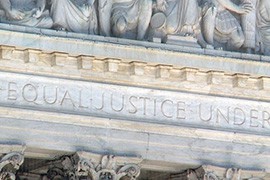Cronkite News has moved to a new home at cronkitenews.azpbs.org. Use this site to search archives from 2011 to May 2015. You can search the new site for current stories.
As Supreme Court starts session, Arizona again lands on court calendar
WASHINGTON – When the Supreme Court starts its term Monday, several things are sure to happen.
The nine justices will wear black. White quill pens will decorate the counsel tables. Justice Clarence Thomas will not ask any questions.
And Arizona will have at least one case argued before the court during the term.
“Arizona has had an unusually large amount of interaction with the Supreme Court,” said Paul Bender, a professor at Arizona State University’s Sandra Day O’Connor School of Law. “And why that is I have no idea.”
The court has already agreed to hear two cases from the state. One is a beef between the town of Gilbert and a local minister over city code that restricts the church’s ability to advertise its services. And the court said Thursday that it will consider the Legislature’s challenge of the Arizona Independent Redistricting Commission.
Several other cases from the state are already in the pipeline but have not yet been granted a writ of certiorari – the formal term for the justices agreeing to hear a case.
The state’s upcoming appearances before the justices come after several years in which Arizona cases had a high profile in the court. In 2012, the court struck down parts of SB 1070, the state’s tough immigration law, and in 2013 the justices rejected most of a voter-approved Arizona law that required proof of citizenship before someone could register to vote.
Experts say that level of activity before the court is not the norm for a state of Arizona’s size.
For most states, it’s rare to have a case make it all the way to the Supreme Court, Bender said, but it has become commonplace for as many three cases to make it every year.
It is not a new phenomenon. The 1966 case, Miranda v. Arizona, led to the “Miranda rights” familiar to anyone who has watched a TV cop show, which require that police warn suspects of their rights before interrogating them. Arizona v. Grant in 2009 made it harder for police to search vehicles without cause.
But some experts say Arizona may be getting the court’s attention as much for where it sits as for anything it does.
Elizabeth Slattery, a Heritage Foundation legal fellow, noted that Arizona is part of the largest court circuit in the country, the 9th U.S. Circuit Court of Appeals. Since it’s the largest, she said, it’s not surprising that so many cases from that circuit reach the high court.
“It depends on the issues in the circuit – it’s more circuit-focused than state-focused,” she said.
But Slattery agreed that the odds are long for any case to be heard by the Supreme Court, which gets about 10,000 petitions for certiorari in a typical year.
“They hear roughly 70 cases per term where they have a full briefing, oral argument and decision,” she said.
Besides Reed v. Town of Gilbert and Arizona State Legislature v. Arizona Independent Redistricting Commission, the two cases the justices have already agreed to hear, at least two more from Arizona are in the pipeline.
The court earlier this year asked for the Solicitor General’s views on Kimble v. Marvel Enterprises Inc., a fight over royalties for the Tucson inventor of the Spider-Man web shooter.
And Ryan v. Hurles, a death penalty case that the justices considered in 23 straight certiorari conferences before it was withdrawn this spring, is back on the list.
But Bender said he was surprised there were so few petitions from Arizona so late in the year, based on the state’s history with the Supreme Court.
“I would expect more than three or four cases from Arizona,” he said.
“I don’t think there are very many states that expect a case every year, but Arizona is one of them,” he said.










